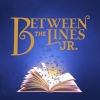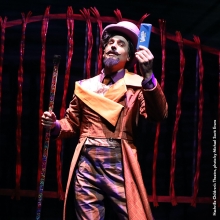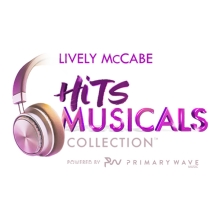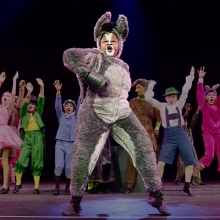Filichia Features: Disney's Peter Pan, Jr. Flies with “Penguins”
Filichia Features: Disney's Peter Pan, Jr. Flies with “Penguins”
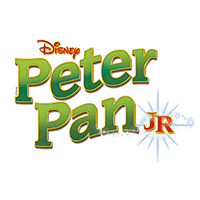 In his program bio, Will Shunk stated that he is “a fifth grade student” who was “born with CP” -- cerebral palsy – “which affects his ability to control his body.”
In his program bio, Will Shunk stated that he is “a fifth grade student” who was “born with CP” -- cerebral palsy – “which affects his ability to control his body.”
Shunk then added, “He hasn’t let it get him down. He’s had a wonderful time being part of Disney's Peter Pan, Jr.”
That happened thanks to directors Chad-Alan Carr and Ann Walsh, who last January sent out a call to disabled individuals aged eight to 21 in the Gettysburg (PA) Area School District. Youths with cerebral palsy, Down Syndrome, autism, learning disabilities, visual and hearing impairment and other neurological disorders were more than welcome. Carr and Walsh would be staging the hour-long musical with youngsters who’d never or rarely before been on stage but wanted to try. Best of all, there would be no tuition.
Carr and Walsh accomplished this by joining forces with The Penguin Project, a marvelous organization founded ten years ago by Dr. Andy Morgan. He chose the name because penguins are as playful, curious and cooperative as other birds but they also have a “disability” that distinguishes them from their fine-feathered friends: they can’t fly.
“Instead,” said Morgan, “they waddle, toboggan on their bellies over snow, swim and thrive in their own environment equally as well as any other bird.”
So Carr and Walsh would as much as possible accentuate the positive and eliminate the negative in mounting Disney's Peter Pan, Jr. But what could they do with Shunk, who uses a motorized wheelchair?
What Carr decided may well be the smartest casting decisions I have ever, ever seen in more than a half-century of continuous theatergoing. He had four large wooden panels painted green and made certain that two of them also sported menacing-looking white teeth. The panels were then attached around Shunk’s wheelchair, giving the show the Crocodile that would hunt and hound Captain Hook. How the audience adored seeing Shunk zoom across the stage in chase of the cowardly pirate.
Shunk didn’t accomplish this alone, which brings us to the page of the program that offered the cast list and the actors who played the roles; three columns were there instead of the usual two. Ah, you’re thinking, Carr and Walsh double-cast everyone. No – that third column consisted of “peer mentors.”
Each young artist with a disability was paired with one without disabilities who was approximately the same age. These volunteers stood next to the penguins, worked with and guided them through four months of hour-long, twice-a-week rehearsals and the two performances at Gettysburg Area High School Auditorium. “But,” said Carr, “although the peer mentor was there side by side as a friend, the artist with the disability had the responsibility of the role.”
Added Morgan, “Such a production truly becomes a life-changing experience for everyone. Children with disabilities have limited opportunities to participate in community activities and to make friends. They are often socially isolated, so this program gives them the opportunity to develop much-needed social networks, self-esteem, social and communication skills. They display their abilities, not their disabilities. Meanwhile, mentors have the opportunity to grow as compassionate helpers because they gain a better understanding of individuals who have special needs.”
Casting Shunk wasn’t Carr’s only brainstorm. He shrewdly realized that with all the talk about Peter Pan’s shadow, he could have a clad-in-black girl play it and replicate Peter’s every move. And if Peter can have a shadow, why can’t Wendy, too? Here was a smart way of getting more kids involved, en route to a cast of 56.
So no fewer than five girls dressed in gowns worthy of cotillions functioned as narrators. At first, each lass looked to her left and to her right as if to say, “Now?” but that uncertainly soon passed. Hey, if after all these years Barbra Streisand still claims to have stage fright, why shouldn’t these neophytes?
When the chorus sang “Never Smile at a Crocodile,” it was quite together in offering three finger points on “Never Smile” and three handclaps on “Crocodile.” When two girls playing mermaids moved their legs up and down, they weren’t just doing the choreography that they’d been taught by Marilyn Lopes; they had advanced to the point where they were genuinely feeling the freedom that a mermaid has in the deep blue sea.
In the title role, Rhiannon Calp constantly showed how secure she was. After she said, “Wendy’s my friend; she’s coming with US,” she made a definitive head-nod that short-circuited any potential argument. As terrific as Calp was, this was the first time I realized how demanding a role Captain Hook is. For one thing, an actor must also double as Mr. Darling. Nevertheless, Colin Kersey was letter-perfect and very much in character for each role, adopting a deliciously low voice for Hook when delivering his many, many lines.
And frankly, after experiencing two productions of the Barrie play and eight trips to the famous 1955 musical, I have never seen a better Smee than TJ Williams. In conjunction with Carr and Walsh, Williams wasn’t interested in simply providing comic relief, but gave us the impression that the pirate ship would be better off if he were in charge. Here’s hoping that after Shunk’s Crocodile dispensed with Kersey’s Hook that TJ Williams’ Smee got the job.
And what, you ask, of the flying? Spreading arms out wide and running in circles was enough to suggest that Wendy, Michael, John and Peter were airborne.
But in a more important way, Disney's Peter Pan, Jr. did fly in Gettysburg. True, there was the occasional misstep. We gladly gave our forbearance to a little girl who failed to exit and stayed in place on stage as her castmates were sauntering off. When she finally realized the time had come and gone for her to leave, she started running off, but hearing our fond laughter made her give us an affectionate wave before she went into the wings.
(We loved it.)
One girl with Down Syndrome didn’t feel confident enough to sing in her first scene, but by the second she was joining in. Every now and then a kid would start a line, pause indecisively midway through, but would rally and quickly show he knew what the rest of it was. If one did totally forget to come in, the performer next to him or – a last resort – his mentor would cue him.
It’s called teamwork.
Watching the audience filled with parents, relatives, friends and well-wishers was a show in itself. The applause steadily grew from appreciative to wild. At the curtain call, as the titanic sound hit the stage, many a young actor dared to give a sideward glance to another as if to say “Well, I thought we were pretty good, but I guess we really are.”
Morgan wasn’t surprised at the applause, for he’s heard it time and time again in many states since he started The Penguin Project in East Peoria, Illinois. “The kids’ parents have the opportunity to see their children shine in ways they never thought possible,” he said.
Carr and Walsh also gave each participant more self-actualization by adopting a famous Fosse move, having him tell his name to the crowd. Greater applause was the result.
Said Carr, “Even as a young child, theater arts created a special safe, comfort zone environment for me. That’s what The Penguin Project does for children with disabilities, too. When I opened The Gettysburg Community Theatre in 2009, I chose as our motto ‘Find Your Stage Door… and Open It!’ The Penguin Project truly opens doors by encouraging each child to be confident and have fun at the theater.”
Summing up, Morgan said, “By providing access, The Penguin Project demonstrates that the special challenges of a disability need not handicap a child’s ability to participate in life’s experiences. Our ‘penguins’ may not be able to fly, but their spirits can still soar on stage.” If you’d like a Penguin Project production in your neck of the woods, visit www.penguinproject.org
 You may e-mail Peter at pfilichia@aol.com. Check out his weekly column each Tuesday at www.masterworksbroadway.com and each Friday at www.kritzerland.com. His new book, Strippers, Showgirls, and Sharks – a Very Opinionated History of the Broadway Musicals That Did Not Win the Tony Award is now available at www.amazon.com.
You may e-mail Peter at pfilichia@aol.com. Check out his weekly column each Tuesday at www.masterworksbroadway.com and each Friday at www.kritzerland.com. His new book, Strippers, Showgirls, and Sharks – a Very Opinionated History of the Broadway Musicals That Did Not Win the Tony Award is now available at www.amazon.com.









